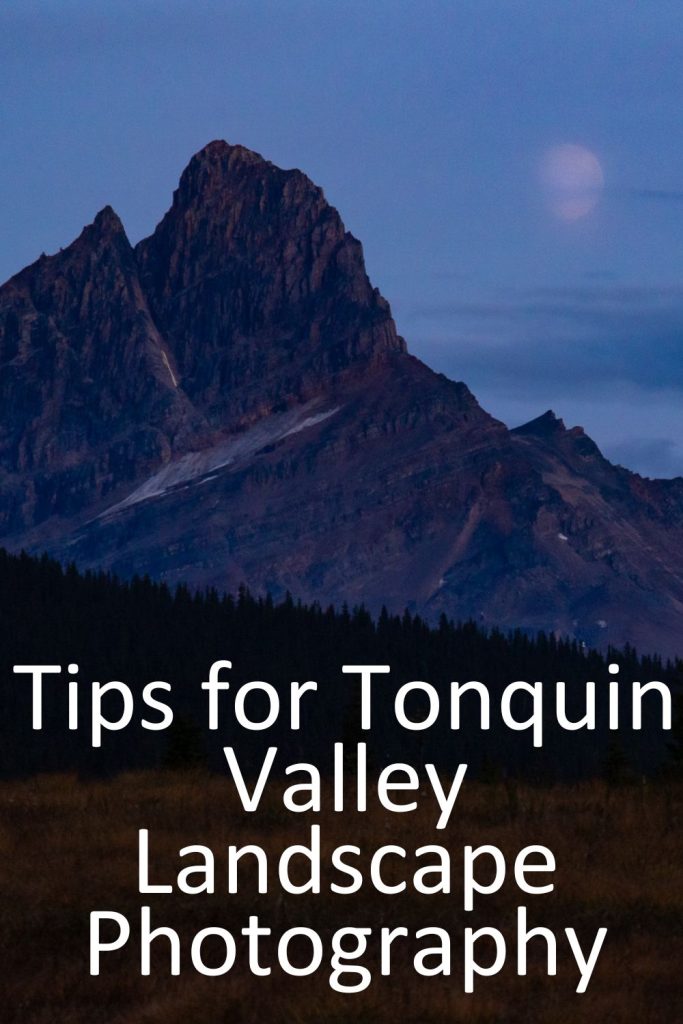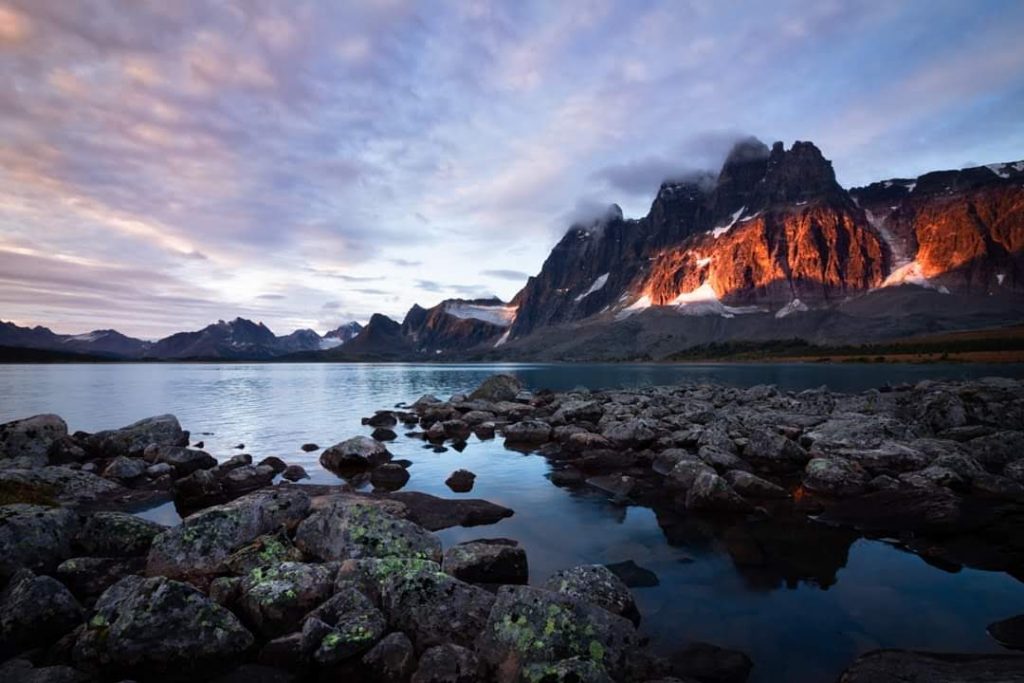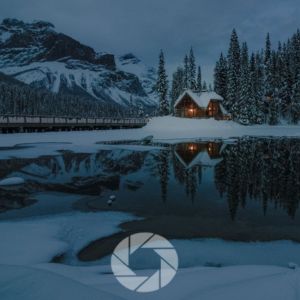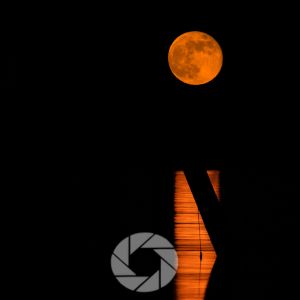
Deep in the backcountry of Jasper National Park lies one of the Canadian Rockies’ most breathtaking treasures: the Tonquin Valley.
Known for its rugged peaks, turquoise lakes, and hauntingly beautiful silence, this valley is a dream for photographers who are willing to venture off the beaten path.
Unlike roadside viewpoints in Jasper, reaching the Tonquin requires effort, but for those who make the journey, the rewards are extraordinary.
In this guide, I’ll share Tonquin Valley photography tips that combine practical advice with reflections from my time in this remote wilderness.
From photographing Amethyst Lake at dawn to capturing the towering Ramparts at golden hour, you’ll learn when to go, what to bring, and how to honor the land while creating your images.
I receive a small commission from links in this post, thank you for your support
Tonquin Valley Photography – Jasper National Park
Tonquin Valley Landscape Photography
Photographing in Tonquin Valley is different from many other places in Jasper. It’s not a location you stumble across while driving the Icefields Parkway; it’s a destination that requires commitment.
Most photographers arrive either by a multi-day backpacking trip or by horseback tours arranged through local outfitters. That sense of remoteness is part of what makes the photographs here feel so special.
Wide-angle lenses are essential for capturing the sheer scale of the mountains, but don’t forget a telephoto. The valley’s distant peaks, wandering wildlife, and compressed layers of forest and rock all lend themselves beautifully to longer focal lengths.
This is a place where Earth dominates your frame: rugged stone walls, ancient moraine, and trails that remind you how small we really are in this landscape.
Discover Your Next Journey – These Tours are designed for people who connect with light and landscape.
Tonquin Valley Landscape Photography
Head over to my fully immersive Tonquin Gallery to see more images.




Tonquin Valley Hiking Photography Tips
Because Tonquin Valley is a backcountry destination, hiking is part of the photography experience. You’ll be carrying your gear through long days and unpredictable mountain weather. Here are some tips to make it manageable:
- Pack light but smart: Bring a versatile zoom lens (24–70mm or 24–105mm) and one specialty lens (wide or telephoto). Leave the rest behind.
- Tripod choices: A lightweight carbon-fiber tripod works best; stability is essential for sunrise, sunset, and night photography.
- Weather prep: Conditions can shift quickly; pack rain covers for both yourself and your camera.
- Timing: The best light requires early mornings and late evenings; plan your hikes with extra time to set up before golden hour.
These hikes remind me of the Air element; weather sweeping through, mists rising off the lake, and wind whispering through the alpine meadows. Patience with the elements often leads to your best images.
Photography Gear to Bring to Tonquin Valley
Here are the things I bring with me as a basic kit, yours may differ, and I add or remove things depending on what is available to shoot.
- Sturdy Tripod
- Zoom (Canon 24-105mm)
- Long Range Zoom (100-500mm)
- Wide Angle (Rokinon 14mm)
- Remote Trigger (or use in Camera timer)
- Lens Cloths
- A knee pad or something to kneel on in wet conditions
- ND Filters
- Polarizer
Tonquin Valley Landscape Photography: Amethyst Lake
Amethyst Lake is the crown jewel of Tonquin Valley. Ringed by larch trees and backed by the jagged Ramparts, it’s a natural mirror that shifts character with every hour.
At sunrise, the lake often reflects pink skies and glowing peaks. A polarizer helps cut glare, but sometimes leaving the reflections slightly hazy adds to the mood.
In autumn, golden larches frame the shoreline, creating some of the most vibrant compositions in Jasper. Shooting wide to include both the trees and the Ramparts creates a layered storytelling image.
Amethyst Lake embodies Water; always changing, always reflecting. Photographing it feels like photographing the soul of the valley itself.



Ramparts Tonquin Valley Photography
The Ramparts are a sheer wall of peaks rising dramatically above Amethyst Lake. Their rugged forms dominate any photograph, whether silhouetted at sunset or glowing under starlight.
For sunrise, position yourself along the lake’s western shore to catch first light on the Ramparts. At sunset, try to take images of the Ramparts from the nearby pond to the west of the lake.
Try longer exposures to soften the water and highlight the warm glow on the rock. A telephoto lens (100–200mm) isolates individual spires and reveals the textures of stone against the sky.

Below is the Fire element of Tonquin Valley: the Ramparts catch and hold light in ways that ignite your images with power and drama.

Wildlife Photography Tonquin Valley
Tonquin Valley is home to grizzly bears, moose, elk, and countless smaller creatures. While wildlife encounters are often fleeting, they can become some of your most memorable photographs.
- Safety first: Always carry bear spray and know how to use it. Photograph from a distance and never approach animals.
- Best lens: A 100–400mm zoom balances reach with packability.
- Composition tip: Include elements of the valley (trees, peaks, lake reflections) to create context-rich wildlife images.
Wildlife embodies the spirit of interconnectedness here; a reminder that this is not just a place for us, but a home for countless beings who belong to the valley.
Best Time to Photograph Tonquin Valley
The Tonquin is accessible primarily from late July to early October.
- Summer: Wildflowers bloom in meadows; long daylight hours give plenty of shooting time.
- Autumn: September brings golden larches, crisp skies, and fewer bugs — a dream for photographers.
- Winter/Spring: Access is limited, but ski expeditions are possible for advanced backcountry travelers.
Seasonality here echoes the Wheel of the Year. Each phase transforms the valley, offering photographers new ways to see and honor the land.
Tonquin Valley Night Photography
While I didn’t engaged in any astrophotography (I was new to photography and didn’t think to try for astro) Tonquin Valley’s isolation makes it ideal for night photography. With almost no light pollution, the Milky Way shines vividly above the Ramparts.
For astrophotography:
- Use a wide lens (14–24mm) at f/2.8 or faster.
- Set ISO between 3200–6400 with 20–25 second exposures.
- Experiment with star trails by stacking multiple long exposures.
There is something profoundly spiritual about photographing under these skies. The Water element appears again; the stars reflected in Amethyst Lake, blurring the line between heaven and earth.
Practical Advice: Gear & Preparation
- Footwear: Waterproof hiking boots are a must; everything is muddy
- Protection: Bug spray in summer; bear spray year-round (make sure it isn’t expired).
- Filters: A CPL for lake reflections; an ND filter if you want to try long exposures of clouds or water.
- Backup power: Cold nights drain batteries quickly; keep extras warm inside your jacket.
Personal Reflection
What struck me most about photographing Tonquin Valley was not only its beauty, but its silence. Hiking in, the weight of my pack was matched by the weight of anticipation. Each step deeper into the valley felt like a step away from the noise of the modern world.
When I finally stood at Amethyst Lake with the Ramparts towering above, I felt the four elements alive in every direction: Earth in the stone, Air in the shifting skies, Fire in the glow of dawn, and Water in the reflective surface of the lake.
Landscape photography here is more than a technical exercise — it is a dialogue with the land. To photograph Tonquin Valley is to listen, to be patient, and to allow yourself to be shaped by the wilderness as much as you shape your photographs.
Conclusion
For photographers seeking solitude and grandeur, Tonquin Valley photography is unforgettable. From sunrise at Amethyst Lake to starry nights under the Ramparts, this remote valley challenges you to carry your gear, embrace the elements, and see the land with reverence.
Whether you’re planning your first trip into Jasper’s backcountry or returning to capture it in a new season, Tonquin offers endless opportunities to grow both as a photographer and as a human being.
If you’d like to deepen your skills and connect more intentionally with landscapes, consider joining one of my tours. Together, we’ll learn not only how to use our gear, but how to see with presence and gratitude — exactly what a place like Tonquin Valley asks of us.
📸Learn for free!
➡️ FREE Wallpapers and Guides
➡️ DISCOUNTS on future Tours & Tutorials
➡️ TIPS for improving Your photography

I don’t share your Info with anyone. You can unsubscribe at anytime.
- Tonquin Valley Photography – Jasper National Park
- Tonquin Valley Landscape Photography
- Tonquin Valley Landscape Photography
- Tonquin Valley Hiking Photography Tips
- Photography Gear to Bring to Tonquin Valley
- Tonquin Valley Landscape Photography: Amethyst Lake
- Ramparts Tonquin Valley Photography
- Wildlife Photography Tonquin Valley
- Best Time to Photograph Tonquin Valley
- Tonquin Valley Night Photography
- Practical Advice: Gear & Preparation
- Personal Reflection
- Conclusion
- 📸Learn for free!






